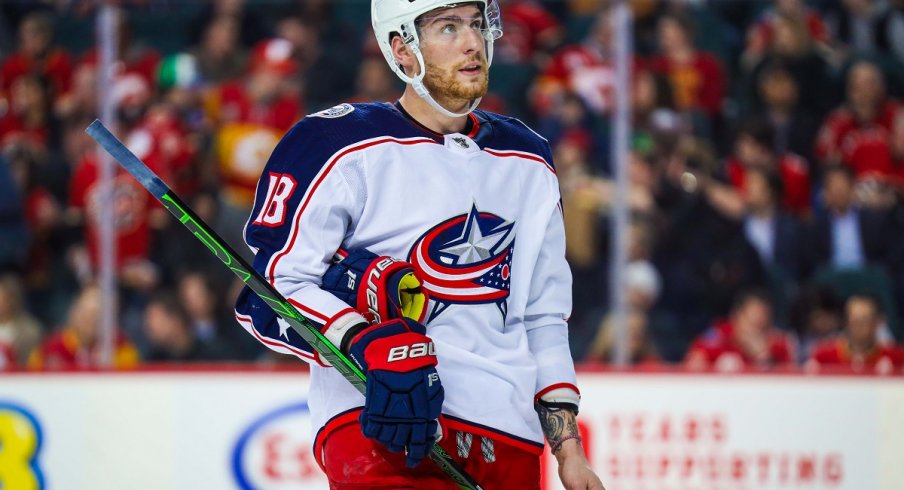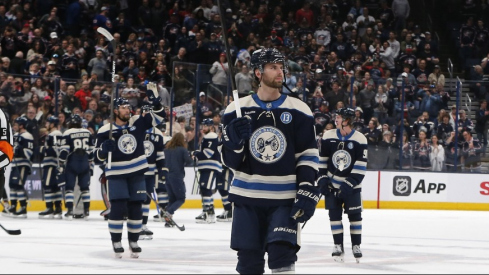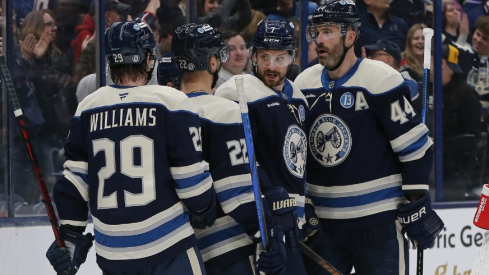Welcome to part one of our State of the Union miniseries, in which we dive deep into the Columbus Blue Jackets' organizational structure to evaluate centers, wingers, defensemen, and goaltenders that are the present and the future of the franchise.
Up first, we'll explore the centers.
Why Are Centers So Celebrated?
One of the old adages in hockey is that teams win 'up the middle'. Elite centers are highly-valued commodities and for good reason. The Pittsburgh Penguins, with Sidney Crosby and Evgeni Malkin, and the Washington Capitals, with Nicklas Backstrom and Evgeny Kuznetsov, have been atop the Metropolitan Division for the past decade, led in large part to their titans in the middle of the ice.
In a vacuum, centers are tasked with more responsibility than any skater on the ice. They act as a third defenseman in the defensive zone (to match up against with his two defensemen to guard the other team's three forwards). In transition, they are often (but certainly not always) the team's primary puck carrying option. And they're regularly the most defensive-minded forward in transition (note: this is a massive generzliation, as F1, F2, and F3 is more common in modern hockey tactics than center, left wing, right wing, and some wingers like Artemi Panarin carry the puck much more than a center).
One quick glance around the NHL will show the emphasis placed on centers. Aside from the Metropolitan Division foes mentioned already, Connor McDavid, Auston Matthews, Nathan MacKinnon, Patrice Bergeron, Ryan O'Reilly all play center. All things equal, NHL teams would practically unanimously draft a prolific center over a prolific winger.
Blue Jackets Top Six Centers
To say the Blue Jackets have never had an elite, blue blood, #1 center is up for debate. Some would say Matt Duchene was that player, but his $8M AAV and 42 points in 66 games this year suggest otherwise. The same can be said of Ryan Johansen, who's provided even less offensive output than Duchene in Nashville.
It's possible that Pierre-Luc Dubois is on his way to becoming a high-end, All-Star-caliber center. Drafted third overall, his pedigree, size, and consistency give him a chance. He's been the Blue Jackets' first-line center for several years, but there's a difference between playing on the first line and being a 1C. At the worst, he's a below-average to average 1C, and there are far worse crimes than that. For what it's worth, Hockey Reference's point-share metrics list him as the top-ranked forward on the team in 2019-20, and The Athletic's Game Scored Value Added (GSVA) metric ranks Dubois as a first-line player, and gave hm a higher score than any other player on the current roster.
After that is where it starts to get a bit dicey. In a perfect world, Dubois is a 2C, but the truth is, this team doesn't have a 2C as it currently stands. Boone Jenner has played center under John Tortorella for a few years, as Tortorella trusts his face-off acumen and overall responsible play. But it's no secret that Jenner excels on the forecheck and along the wall, where wingers are more likely to play. He's filled in admirably, but if this team had another top-six caliber center, Jenner would likely slide back to the wing.
The Immediate Future
But you can't say the Blue Jackets haven't tried to fill the void. They've spent what high-end draft capital they've had in the past few years trying to fortify the position. In 2017, a year after the club drafted Dubois, they traded up into the second round to select Alexandre Texier, and two rounds later took Emil Bemstrom, both of whom were drafted as centers. Then, in 2018, the Blue Jackets used their first-round selection, their only first-round pick in the past three drafts, to select another center, Liam Foudy
While it's more likely that Bemstrom has found a home on the wing, the Blue Jackets should be thrilled about the prospects of having both Texier and Foudy playing center in the not-too-distant-future. Here's Tortorella on Texier:
This is a big part of our future, this kid. He's gonna be able to play. I really do want to give him a chance at center ice. He's a big part of the future of this team."
While the NHL has seemed a bit rich for Texier at times, it's important to remember that he's a 20-year old kid who's way ahead of his projected development curve. He's made huge leaps in each of the past few seasons, jumping from France's top league to Finland's Liiga, then again to the AHL for just seven regular-season games before getting a promotion to the NHL. Texier has recently begun skating after a lumbar stress fracture incurred on New Year's Eve has kept him out of play, could be the club's long-term answer as a top-six center.
Foudy appears ready for the NHL in a full-time capacity, but as I suggested earlier this month, he most likely projects as a third-line defensive-minded center with tempered offensive upside. His elite speed could give him a chance to move higher in the lineup, but he's never been a huge point producer (though he did end his junior career on an 18-game point streak).
Immediate Question Marks
The elephant in the room, perhaps, is Alexander Wennberg, who is due $4.9M for the next three seasons. He's never been able to take the steps that at one point seemed inevitable to a top-six center. After his first three NHL seasons saw him increase his scoring from 20 points to 40 to 59, he's regressed to 35, 25, and 22 in the past three seasons. Just weeks before the NHL season was paused, Tortorella moved Wennberg to the wing in an attempt to jumpstart his offensive game (if you're still hopeful that Wennberg can turn a corner, you have the patience of a saint).
Riley Nash cashed in with the Blue Jackets after tallying 41 points playing higher in the lineup on a highly-skilled Boston Bruins team, but he has not been able to approach that level of productivity in Columbus. He has one year left on a deal that pays him $2.75M. If he makes the team next season, and I would expect him to, it will be in a fourth-line/insurance capacity.
He isn't the only one with an uncertain future. The Blue Jackets traded Sonny Milano for Devin Shore at the trade deadline, but Shore is an RFA this summer. Would the Blue Jackets really trade Milano for six games-worth of a player and then let him walk without submitting a qualifying offer? Maybe, as his AAV of $2.3M may be richer than the value he provides.
Lastly, Kevin Stenlund will also be an RFA this summer. He certainly looked like an NHL player at times this season, but it will be interesting to see if he factors into the team's plan long-term. Personally, I'd rather have a younger/cheaper Stenlund than Shore.
Prospects/Picks
The Blue Jackets have their first-round pick this year, and barring something unexpected, could potentially use that pick to upgrade the center position. Dmitri Voronkov, who the club picked with their fourth-round pick in 2019, has progressed well in the short time since his selection and was a fixture in the KHL at just 19. The Athletic's Aaron Portzline's recent article about the "ramrod center" projects him to be a 6'4, 200 lb future third-line center in the same vein as Jenner. Expected arrival? 2021-22.
Conclusion
The Blue Jackets don't have a Prince Charming waiting in the wings. Top-flight centers don't grow on trees. It's possible that the organization looks to move up in the draft, utilizing some of their well-developed depth, but it's more likely that any growth is internal. Between Dubois, Texier, Foudy, and Stenlund, with Jenner, Nash, and Wennberg there as insurance pieces, the Blue Jackets have plenty of capable centers when hockey resumes. Whether that'll be enough to push them over the hump is a different story.


